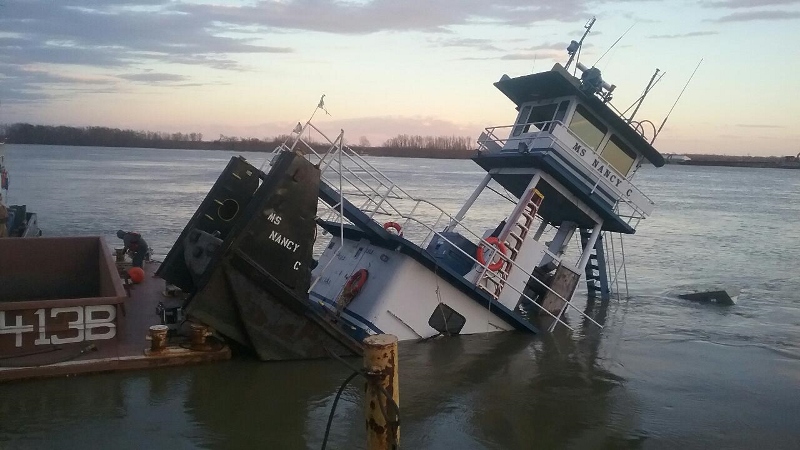Inadequate maintenance that resulted in corrosion and a loss of watertight integrity was behind a March 2018 towboat sinking on Everett Lake, Tenn., the National Transportation Safety Board reported.
The 64.5’x23’x6’, 1,600-hp Ms Nancy C, operated by the Choctaw Transportation Co., Dyersville, Tenn., was moving dry barges on the lake, a tributary of the Mississippi River at mile marker 832, on March 6 at about 4:30 p.m. when a deckhand noticed water filling a stern void.
The deckhand and captain attempted to dewater the vessel with a pair of electric pumps, and as flooding worsened they attempted to retrieve a third pump from the barge they were moving. But the Ms Nancy C was sinking fast by the stern, so the crew had to retreat to the barge as the towboat went down in 15’ of water.

The towboat Ms Nancy C was raised five days after sinking on Everett Lakes near mile marker 832 on the Mississippi River. NTSB photo
The vessel was refloated five days later, and the NTSB and Coast Guard conducted a detailed investigation of the boat’s material condition. The NTSB reported finding hatch covers with missing seals and damaged gaskets, corrosion and wasted steel on the deckhouse that had been patched with doubler plates, and engine room cofferdams with household-grade sump pumps, indicating that the shaft seals leaked.
The deckhand told investigators that the stern void had to be pumped out on a weekly basis. On the day of the sinking, the Ms Nancy C was operating in winds of 28 mph gusting to 34 mph, with whitecaps on the lake and waves 3’ to 4’.
With a freeboard of 2’, “it is likely that waves splashed against the port and starboard sides of the vessel as it was operating within the lake from approximately 0600 until the time of the accident at 1630,” according to the NTSB report. “Rain and water from the waves that puddled on the main deck could have then entered the voids through the loose access covers or wastage at the aft portion of the deckhouse.
“Because the voids of the towing vessel were not fitted with any high-water-level alarms, the crew was not warned of the onset of flooding. In addition, the towboat had no fixed bilge system to remove water from the voids. Therefore, to dewater the spaces the crew had to remove the access covers to the voids and run portable pumps through the accesses.”
The report concludes that the probable cause of the loss – valued at $667,306 – was inadequate maintenance by the owner, “resulting in corrosion and the loss of watertight integrity on the main deck, which allowed uncontrolled water ingress into the vessel’s stern voids.”




